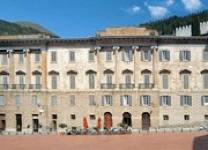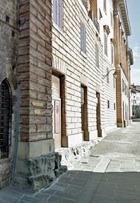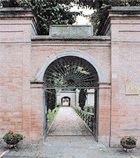

Ranghiasci Family
This family was documented in Gubbio from 1313. Sebastiano Ranghiasci married Antonia Brancaleoni in 1678 and their son, Giuseppe was made a Count in the middle of the 18th century. The most important of his descendants were:
-
✴his sons:
-
•Sebastiano (1747-1822); and
-
•Giacomo (1754-1838); and
-
✴Francesco (1800-77), the son of Sebastiano and heir of both Sebastiano and Giacomo.
Pope Gregory XVI raised Francesco to the rank of Marchese in 1841.
Sebastiano Ranghiasci-Brancaleoni
Sebastiano was a noted archeologist whom Pope Pius VI allowed to excavate the Roman theatre. He established an important archeological collection. He was a prolific writer and also worked on the restoration of San Francesco Assisi (in the native city of his mother, Maria Ipernestre Locatelli).
Giacomo Ranghiasci-Brancaleoni
Giacomo was bishop of Sanseverino from 1816 until his death. He left his collection of coins from the mint of Gubbio to the city.
Francesco Ranghiasci-Brancaleoni
Francesco married the young Matilda Hobhouse in 1827. Under her influence, he became a prominent liberal, and was sent to Bologna as the representative of Gubbio to the assembly of the “Città Libere d’ Italia”at which an anti-papal force was marshaled to march on Rome. The insurrection failed when Austrian forces occupied Gubbio, from whence they threatened Perugia. Francesco Ranghiasci was among those exiled. He returned to Gubbio a year later, and became faithful supporter of the papacy for the rest of his life. He was estranged from Matilda and, after her death in ca. 1853, he married Rita Giordani Andreoli.
Francesco became mayor of Gubbio in 1866. He died intestate in 1877 and the fine art collection in the palace was dispersed in 1882.
Matilda Hobhouse
Sarah Matilda was the daughter of Sir Benjamin Hobhouse and half-sister of John Cam Hobhouse, who was a close friend of Byron. She had some kind of relationship with the exiled Venetian poet Ugo Foscolo and this led to a proposal of marriage in 1824. Her family were apparently appalled and the proposal was rejected. She met Francesco Ranghiasci-Brancaleoni in Rome soon after and married him in 1827. Their two sons, Edoardo Latino and Federico Latino died in childhood, although their daughter Anne Amelia Latina survived into adulthood.
As noted above, it was probably under Matilda’s influence that Francesco joined the anti-papal insurrection of 1831. When the patriot army arrived in Gubbio en route for Rome, Matilda presented it with the tricolore. She probably left for England when the revolution failed. Francesco returned to Gubbio in 1832 but Matilda seems to have remained in England. She wrote her will in December 1853 from 2, Eaton Square, and was buried soon after in the cemetery at Kensal Green.
Palazzo Ranghiasci-Brancaleoni (1820-41)

This palace overlooking Piazza Grande incorporates a number of older buildings, including the “Palatium Vetus” that was made available to Federico da Montefeltro in 1464 (before the construction of Palazzo Ducale). It later passed to the Galeotto family and housed the Zecca (mint) of Gubbio from 1626 until 1759 , when Pope Clement XIII deprived Gubbio of the privilege of coining money.
Giacomo Ranghiasci acquired this Galeotti property in 1820. The complex passed to Francesco on his marriage in 1827 to Matilde Hobhouse. He received permission to build the present neo-Classical façade in 1841. The project required the closure of two narrow streets that had each previously connected what are now Via dei Consoli and Via Galeotti.

[Rear facade with entrance at 40a Via Galeotti]
Parco Ranghiasci-Brancaleoni (1841-8)

The park went into decline after the death of Francesco Ranghiasci-Brancaleoni in 1877. The city bought and restored it in 1988.
A covered bridge across the Camignano in Via Gabrielli leads to the park.
The small brick villa is modelled on Palazzo Ranghiasci-Brancaleoni.
On the hill above is a small neo-classical temple.
This section of the website of the Commune gives a detailed account of the park.

